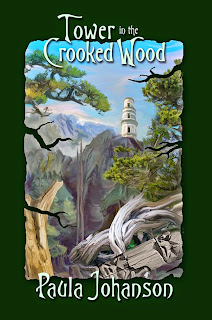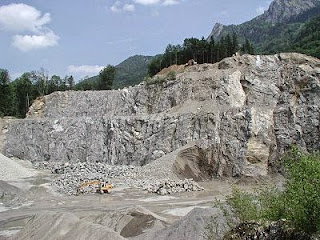Paula Johanson talks about Tower in the Crooked Wood
 |
| ISBN 9781927400913 $12.99 eISBN 9781927400920 $4.99 |
JC: What inspired Tower in the Crooked Wood?
PJ: I’ve been reading fantasy novels since finding a copy of The Lord of The Rings in my school library at age 9. That’s a lot of novels! The inspiration for Tower in the Crooked Wood was learning that a publisher of gaming cards was looking to release novels compatible with their gaming system. It was a reason to try another novel manuscript with a goal in mind. I find publisher’s needs to be very inspiring!
That publishing program folded, but Bundoran Press acquired my novel. When Bundoran retired their fantasy backlist, Five Rivers Publishing acquired a revised edition of Tower in the Crooked Wood.
The inspiration for Tower in the Crooked Wood was learning that a publisher of gaming cards was looking to release novels compatible with their gaming system. It was a reason to try another novel manuscript with a goal in mind.
JC: What would you say is the difference between writing fiction and non-fiction?
PJ: Near as I can tell, there’s a big difference in that readers are looking for content in non-fiction, and for style and tone in fiction. There are more similarities than differences. Non-fiction is so much more successful when it has narrative and overt tone and style choices. Fiction has heaps of content but slides past it, which can lead to cultural assumptions.
JC: Did writing Tower in the Crooked Wood involve research?
PJ: The new research was learning about the gaming system for the gaming cards and saying to myself, “Holy smokes! These cards are a good substitute for writing scenes and characters and settings.” Suddenly I had settings and motivations, and soon I had scenes and characters. It was quite a different experience for me, as usually I begin with dialogue and characters then build from there.
 |
| Gravel pit in Villanueva Alberta, one of the inspiration for the setting of Tower in the Crooked Wood |
JC: Can you give us an insight to the world-building involved in the writing of Tower in the Crooked Wood? Is the setting based on anywhere in reality?
PJ: Building this world involved incorporating real-life experiences from my visits to construction sites, a gravel yard near Villeneuve, Alberta, a limestone quarry in Stonewall, Manitoba, and islands on the west coast, all of which had happened years before. Every setting shown or mentioned in Tower is based on real locations, which correspond in latitude and longitude to where the places would be in Jenia’s world of two moons. Copper Island is a composite of several landscapes in traditional First Nations territory.
 |
| Limestone Quary in Stonewall, Manitoba, one of the inspiration for the setting of Tower in the Crooked Woods |
JC: Can you tell us more about Tower in the Crooked Wood? Would you say it has a character-driven or an action-driven plot?
PJ: Using the gaming cards to start got me thinking about real places which were good matches for the cards. Putting cards together according to rules for the game made narrative sense, and told me what could be happening. From there I realized that it wasn’t essential to write the novel from the point of view of the person who knows everything and is doing the biggest actions.
The plot is driven by the places in the story, and the actions of the characters are secondary. The thoughts and feelings of the characters might seem extremely important to the characters themselves, yet these elements are not first or second but a distant third in determining what happens. Here’s a quote from the book:
This is the story of one person moving in a very big world.
JC: Which came first, the story or Jenia, the character?
PJ: While I knew the settings and the actions first, it wasn’t a narrative until I had a voice to follow through the events. That voice was Jenia’s.
Non-fiction is so much more successful when it has narrative and overt tone and style choices. Fiction has heaps of content but elides past it, which can lead to cultural assumptions.
JC: How was the editing process?
PJ: The editing process for the first edition was different from this revised edition. For Bundoran Press I added a couple of scenes which really improved the novel and made it more complete. For Five Rivers Publishing I have restored some elements which have made the story stronger, and expanded some scenes. I’m really happy to have this new edition released!
JC: How long did it take to write this book? Are there moments you had to deal with writer’s block? How did you push through them?
PJ: The first draft was outlined quickly and didn’t take long to write. It was revised for Bundoran, and again for Five Rivers.
Writer’s block is something that writers deal with in different ways. Usually for me it helps to work on a different kind of writing project, such as poetry instead of non-fiction, or a short story instead of a novel, or a non-fiction book on science instead of a book about magic. I try not to force writing. There’s always so many things that need to be done around the house. And some things, like laundry, can be abandoned half-finished when writing begins to work.
For Five Rivers Publishing, I have restored some elements which have made the story stronger, and expanded some scenes.
JC: Can you describe your writing process?
PJ: Usually it’s very different from writing Tower! I have written a lot of short non-fiction books on science or health or literature for educational publishers. For those books, the editor tells me the topic and asks me to propose a book in the style of their series. By the time I’ve written a table of contents and book proposal, that kind of book is already outlined in detail.
For both non-fiction and fiction, the process of writing for me involves finding how to tell someone about the matter at hand. Facts aren’t dull when you know how they affect people, and characterization isn’t fluff when it connects people and events.
JC: Can you share your writing influences in terms of fiction?
PJ: While I admire and have read many classic works of science fiction and fantasy, I’m most strongly influenced by Ursula K. Le Guin and by The Curve of Time, which was the lone book written by M. Wylie Blanchet.
JC: Are there any writing projects on your table right now? What can we expect from you in the future?
PJ: Currently I’m writing a couple of biographies of Canadian prime ministers for a series from Five Rivers Publishing. This month I’m presenting a couple of papers at a conference on digital humanities, which in about a year I hope to make the core of an academic book for teachers on bringing a student’s real-life experiences to a better understanding of historical and literary works. One educational publisher I write for has acquired the other, and I’m waiting to hear back about a couple of ideas.
In writing Tower, I was not trying to write a history or a grand, over-arching narrative.
JC: What can readers expect from Tower in the Crooked Wood?
PJ: I have grown tired of epic fantasy novels with repeated and endless combat scenes; I’m not sure whether it’s worse when the author has some experience in martial arts or soldiering or when the author has none and skates past important factors. In writing Tower, I was not trying to write a history or a grand, over-arching narrative. This is one story, as seen by one person, learning about her world.
As Alice Meynell wrote: “Art has rightly nothing to do with the history of war, it should be concerned only with its anecdotes. Art should go into the byways of battle. It must love the soldier and love him individually, not in battalions.”
Tower in the Crooked Wood is available June 1, 2015 in both print and eBook formats directly from Five Rivers, or through your favourite online bookseller.
| Format |
![]()
